Use a gentle brush and mild soap, and water to clean and care for rubber fenders. Rinse them well and allow them to dry completely. If the dirt or marine growth won’t come off, use a low-pressure washer or a stiffer brush with a marine cleaner made just for that. Avoid using harsh chemicals and petroleum-based solvents on the rubber, as they might harm it. You might also want to think about putting a UV-protectant coating on the fender to make it last longer.
These tips will help you make your marine rubber fender last longer and make it safer. Following these measures can cut down lower maintenance costs and make the docking process more effective. This might add 40–60% to the service life of the fender.
Table of Contents
Understanding Rubber Fenders and Their Importance
Rubber fenders are more than simply safety gear. They are necessary for safe and effective docking. Fenders are made to absorb the kinetic energy of a ship docking, which lessens the damage and the impact. This not only makes docking go more smoothly, but it also cuts down on downtime and possible repairs. Port operators may greatly improve safety and lower the costs of ship damage by using high-quality rubber fenders.
Think of fenders as part of a bigger safety system to get the most value out of them. Keeping things in good shape isn’t only about making them last longer. It’s also about avoiding mishaps that might cost thousands of dollars in repairs or time missed. Adding fender care to regular tasks can make ports work better in a measured way.
Why Proper Maintenance Matters
To make sure that rubber fenders last a long time and work well, they need to be taken care of properly. Regular cleaning and checking might help find problems before they get too big. By taking care of your rubber fenders, you can make them last longer, cut down on how often you need to replace them. This can make sure they work the same way every time you use them.
If you don’t take care of your fenders, they could become structurally weak. This could lead to catastrophic accidents and big financial losses. At Henger Shipping Supplies, we stress how important it is to have a regular maintenance program that includes inspections, cleaning, and repairs before they happen. We see maintenance as an investment because data shows it may cut costs by 25–35% while making things safer.

Essential Inspection Procedures for Rubber Fenders
A thorough inspection process is necessary to make sure that rubber fenders work as well as they can. Regular checks are very important for keeping these important parts in good shape and making them last as long as possible. Do a baseline assessment after installation to see what normal conditions are like.
Visual Inspection Techniques
The first step in keeping rubber fenders in good shape is to do visual checks. We suggest doing visual examinations after each major berthing operation to look for any signs of damage or deterioration right away. This means looking for fractures, cuts, or scrapes on the fender’s surface that could make it less strong. Ports conducting these inspections can detect early signs of wear, thereby preventing system failures caused by rubber fender aging.
Checking for Signs of Wear and Damage
When looking at rubber fenders, it’s important to look for signs of wear and damage that could impair how well they work. Look for signs like deformation, patterns of wear that are too severe, or damage caused by berthing procedures. Keeping a record of these observations helps keep track of how the fenders are doing over time. Tools like photo logging apps make things more accurate.
Creating an Inspection Schedule
For the upkeep of rubber fenders, it is very important to make a full inspection routine. Every three to six months, or more often if the weather is bad, inspections should be done. The plan should take into account things like UV exposure, very hot or cold weather, or chemicals that could be harmful. Here’s a table that is organized to help you:
| Inspection Frequency | Environmental Conditions | Recommended Actions |
| Every 3-6 months | Normal conditions | Visual inspections, check for wear and damage |
| More frequently | Harsh conditions (high UV, extreme temperatures, chemical contaminants) | Detailed inspections, consider additional protective measures, including pressure checks for pneumatic types |

Effective Cleaning Methods for Rubber Fenders
The effectiveness of rubber fenders is significantly enhanced by proper cleaning techniques. Regular cleaning not only maintains their performance but also prolongs their lifespan. We recommend thorough cleaning to ensure your rubber fenders remain in optimal condition. It is best to incorporate this into your monthly cleaning routine.
For cleaning rubber fenders, mild soap and soft-bristled brushes are recommended. These tools are gentle on the rubber material while effectively removing dirt and marine growth. Avoid using harsh chemicals or abrasive tools that can damage the fenders. For example, in saltwater-heavy areas, this method has prevented degradation.
Here’s a step-by-step cleaning process:
- Scrub the rubber fenders regularly with a soft-bristled brush to remove any marine growth and pollutants. This protects the fender from degradation.
- Rinse the fenders thoroughly with fresh water to remove any residue and maintain surface quality.
- Dry if possible, or allow air drying, and apply a UV-protectant spray for added longevity.
When cleaning rubber fenders, there are several things to avoid:
- Never use petroleum-based solvents, strong acids, or alkaline cleaners. Because these can cause swelling or accelerated aging of the rubber.
- Avoid abrasive tools like wire brushes or metal scrapers that can scratch the surface.
- Do not use high-temperature steam cleaning or bleach-based cleaners. Additionally, do not leave cleaning agents on the fender for extended periods.
Following the manufacturer’s manual for rubber fenders can help avoid common mistakes.

How to Maintain and Clean Rubber Fenders in Different Environments
Different environmental conditions necessitate tailored maintenance approaches for rubber fenders. The performance and service life of these fenders are significantly influenced by their operating environment. For instance, exposure to seawater, freshwater, and industrial conditions. Therefore, we must adjust our strategy to ensure their resilience.
Rubber fenders exposed to saltwater environments require meticulous maintenance due to the corrosive nature of salt. Regular cleaning is essential to remove salt residues that can degrade the rubber over time. We recommend rinsing the fenders with fresh water regularly and applying a protective coating to prevent salt damage.
In freshwater environments, rubber fenders are less prone to corrosion. But it still requires regular maintenance to address issues like algae growth and sediment accumulation. In industrial settings, fenders are exposed to chemical pollutants and abrasive particulates, necessitating frequent inspections and appropriate cleaning protocols. Here’s a quick reference table:
| Environmental Condition | Maintenance Requirement | Recommended Action |
| Saltwater | Regular cleaning | Rinse with fresh water, apply protective coating |
| Freshwater | Address algae growth and sediment | Clean regularly, inspect for sediment accumulation |
| Industrial | Protect against chemical pollutants | Inspect frequently, clean with appropriate solutions |

Addressing Common Wear and Tear Issues
Wear and tear on rubber fenders can lead to significant performance and safety issues if not addressed properly. Regular inspections and maintenance are key to identifying potential problems early. Proactive handling prevents escalation.
Critical damage patterns on rubber fenders can include deep cracks, significant deformation, or extensive material loss. Identifying these issues promptly is crucial for maintaining fender functionality and ensuring safety. We recommend regular visual inspections to catch these problems early.
Deciding whether to repair or replace a damaged rubber fender depends on several factors. These include the extent of the damage and the age of the fender. Minor damage, such as small surface cracks or light abrasions, can typically be repaired.
However, significant structural damage often necessitates replacement to ensure optimal performance and safety. We advise consulting with fender specialists to determine the best course of action. Because improper decisions can lead to repeated issues, like in overused buckling fenders.
Conclusion
To maximize the lifespan of your rubber fenders, you need to maintain them in several ways. For example, perform regular inspections, clean them properly, and repair them when necessary. At Henger Shipping Supplies, we’ve seen that rubber fenders that are adequately taken care of can last 40–60% longer than predicted. This saves port facilities a lot of money and makes their operations run more smoothly.
By putting a maintenance plan in place, you not only make your fenders last longer, but you also make sure they work well, protecting both ships and docking structures. Maintenance records can generate useful historical data. This data can be used to progressively improve maintenance procedures. In the long run, investing in proper maintenance pays off. It enhances safety during offshore operations and reduces repair costs.

FAQ
How often should I inspect my rubber fenders?
We recommend inspecting your fenders regularly, ideally every 3-6 months, or after significant use. This frequency helps identify potential issues before they become major problems. Adjust based on the environment for the best results.
What are the signs of wear on rubber fenders?
Signs of wear include cracks, cuts, abrasions, and discoloration. If you notice any of these, it’s essential to assess the damage and consider repairs or replacement to ensure continued protection. Early detection is key.
Can I use harsh chemicals to clean my rubber fenders?
No, we advise against using harsh chemicals, as they can damage the material. Instead, use mild soap and water to keep your fenders in good condition. This preserves integrity over time.
How do environmental conditions affect rubber fenders?
Environmental conditions, such as exposure to saltwater, UV radiation, or extreme temperatures, can impact the durability of your fenders. Regular inspections and proper maintenance can help mitigate these effects. Tailor your approach accordingly.
How can I identify critical damage patterns on my rubber fenders?
Look for deep cracks, significant abrasion, or deformation. If you’re unsure about the extent of the damage, consult a professional for an assessment. Documentation aids tracking.




